2023.08.01.71
Files > Volume 8 > Vol 8 No 1 2023
Rafil Hameed Rasheed 1,*, Rehab Faisal Ahmed 2
1 Al-Farahidi University, College of dentistry;r [email protected].
2 Al-Anbar University, College of dentistry; [email protected].
* Correspondence: [email protected].
Available from: http://dx.doi.org/10.21931/RB/2023.08.01.71
ABSTRACT
A woman is susceptible to oral diseases at various stages in her life span. Besides, multiple biological, behavioral, and social factors affect the general health condition. Many drugs or chemicals can influence the oral cavity & associated structures. An example of these drugs group is oral contraceptive pills (OCS) which women widely use to prevent pregnancy and determine the number of children, and hormonal therapy. This study aims to evaluate the effect of oral contraceptive pills use on salivary secretion and composition in addition to the occurrence of any oral manifestations with the uses of these drugs among women aged 16-45 years. The total number of sample subjects is 51 women. The samples were separated into two groups: The first group included 21 unmarried women with no previous experience with oral contraceptive pills (control group).
In contrast, the second group consisted of 30 women who were married and using this drug (study group). This study is considered to be a comparative study between these two groups concerning the analysis of the salivary composition, unstimulated salivary flow rates and PH level: The results obtained from this study showed a marked significant difference in salivary analysis between the drug user & nonuser drug groups concerning the salivary flow rate while the PH had no statistical differences between them. However, the two groups had a significant difference in alkaline phosphatase enzyme. The salivary analysis showed highly substantial variations in immunoglobulin A (IgA) & total protein levels in saliva between control & study groups; also, in this study, there was a positive association between gingival inflammation with gingival index score (2) (80%), gingival index score (3) (100%) and duration for taking the drug. By this drug administration, the altered salivary flow rate & levels of salivary contents that include (secretary proteins, IgA and enzymes) may influence and play an essential role in oral & dental health.
Keywords: saliva; oral health; oral contraceptive pills.
INTRODUCTION
One of the critical parameters that families need to put under control is the number of children and the selection of the time of pregnancy. Sex hormones affect females throughout their life, starting from puberty, peaking in pregnancy, and persisting up to and even after menopause. During these fluctuating hormone levels, many medical and dental problems may be present1. The discharge of Luteinizing Hormone (LH) and Follicle Stimulating Hormone (FSH) was decreased by Estrogen hormone, which resulted in the prevention of ovulation and proposed the change in the secretion of the uterus with less possibility of implantation to happen 2.
Saliva is involved in the defense mechanism of the oral cavity by various mechanisms; one of these is the salivary component, and many proteins are related to local host defense 3. Many important enzymes are associated with cell injury & cell death, just as aspartate & alanine aminotransferase, lactate dehydrogenase, and alkaline & acidic phosphatase; any disturbance in enzymatic activity reflect metabolic changes in the gingival & periodontium inflammation 4. In the oral environment, the main immunoglobulin present in the saliva is immunoglobulin A (IgA), considered the first line of immune defense in the mouth and is responsible for inhibiting bacterial adhesion on the enamel surface 5. The goal of this study is to estimate the salivary flow rate, PH, and oral manifestation as a fate of using the drug and to find a difference in salivary parameters levels as immunoglobulin A (IgA), total protein and alkaline phosphatase (ALP) between subjects with oral contraceptive drug intake and healthy subjects.
MATERIALS AND METHODS
The sample population of this study comprised 51 women their age range (of 16-45 years) divided into two groups: The first group consisted of twenty-one non-married normotensive women & used as the control group, and the second group consisted of thirty married women, using contraceptive pills for periods not less than six months, and used as a study group. The two groups were school teachers and private gynecology clinic patients, and the collection and screening occurred within three months. General information was taken from each woman, including her name, age, address, occupation, number of children, and any previous abortions, in addition to each woman's medical history. All this information was recorded in a particular case sheet form for each woman after taking consent from all subjects. According to Loe & Silliness (1963), the gingival index system is used to determine the occurrence of gingival inflammation at (4) surfaces of the teeth. The saliva samples were collected in the afternoon between (1- 3.30 p.m.), and at least 1 hour after lunch. Samples were taken following washing & rinsing of the oral cavity with water to remove any debris & contaminating materials. The unstimulated whole mixed saliva was usually collected with the subject sitting quietly using the spitting method; each subject was seated on a chair with the head bent forward to a horizontal Position. The subjects were instructed to accumulate saliva in the mouth and then spit into a clean graduated glass tube. The time of collection was 10 minutes. A PH paper was used to determine the PH values of salivary samples collected before the centrifugation. The average salivary PH value was recorded, and then the samples were centrifuged at 4500 r.p.m. for 15 minutes to measure the saliva's flow rate, which was recorded in ml/10min. The samples were separated & stored at -20c in a deep freeze until the time of the analysis. Salivary samples undergo the lyophilizing process to increase the concentration of all salivary components; each saliva sample was located in a chamber of lyophilize apparatus (Freeze Dry System/Free zone 4.5Labconco). Then the lyophilizing process was done through two stages: the freezing stage was the temperature reached (-20ċ), and the vacuum stage absorbed all the moisture from the sample. The biochemical analysis measures total salivary protein, alkaline phosphatase and IgA. In the present research work, the one-way analysis of the variance, t-test & simple linear correlation coefficient was used. The one-way analysis of the variance was used to test a hypothesis that says means for each salivary parameter.
RESULTS
Table 1 shows the mean age was 23.60 years in the control group. The standard deviation was 5.46 years with an age range of 16-32 years, while the mean age was 32.60 years in women (OCS users), and the standard deviation was 6.63 years with an age range of 21-45 years. In the resting saliva of the control group in table (2), the mean PH value showed no statistically significant differences (7.400 + 0.598) from that of the study group (7.667 + 0.661) (P < 0.05), also in table (2) the flow rate value of unstimulated saliva in the control group was highly significantly lower than that of the study group, the (P.> 0.0001) which is shown in (table 3). In table (2), the alkaline phosphatase (ALP) mean value in the whole resting saliva of the control group exhibits a significantly lower level compared with the mean value in the resting whole saliva of the study group. A statistically significant difference was observed between the two groups (P > 0.05) (table 3). The immunoglobulin A (IgA) mean value in the resting saliva of the control group was shown in (table 2), a significantly higher level when compared to the study group. A statistically highly significant difference was observed between the control and study groups. The mean value of total protein in the resting saliva of the control group was higher than that of the study group, so a statistically highly significant difference was observed between groups (p> 0.0001) (table 3). In table (4), the data illustrated that there is no obvious change in the oral mucosal tissues with women drug users. Table (5) shows the high percentage of OCS users was in the duration of (12 -24) months and then (6-12) months. There was a positive association between Gingival Index and the drug's duration. A GI score (2) was strongly positively associated with the duration of taking the drug (24-36 m) (80%); the same was true for the gingival index score (3) (48-60 m) (100%) (Table 6)

Table 1. Age distribution, age range, Mean + SD, CV of the control & study groups
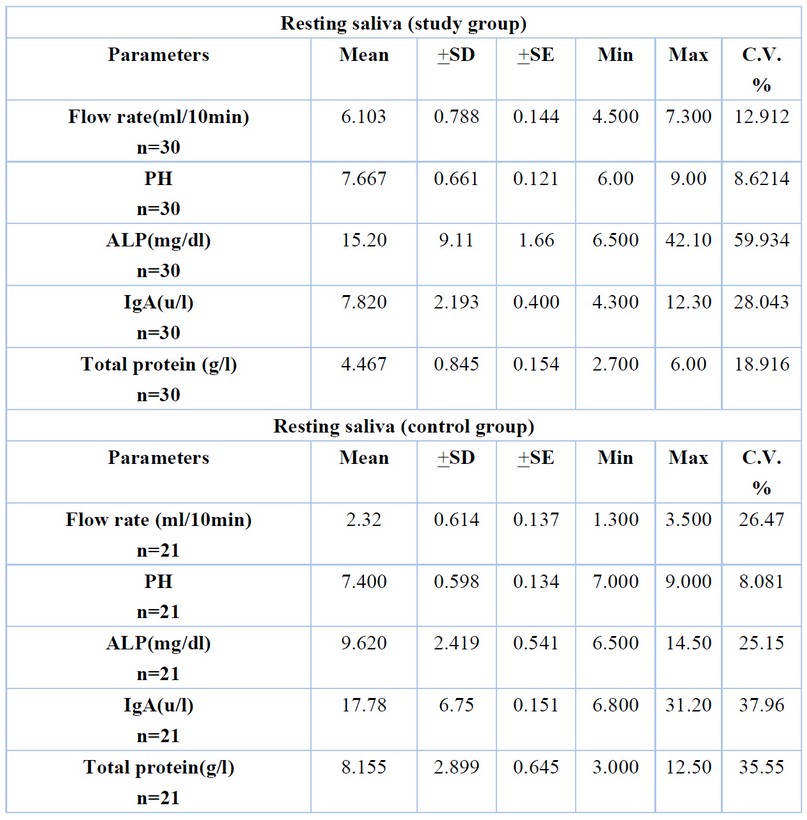
Table 2. Salivary flow rate, PH and biochemical Data of the resting human whole saliva of the study & control groups
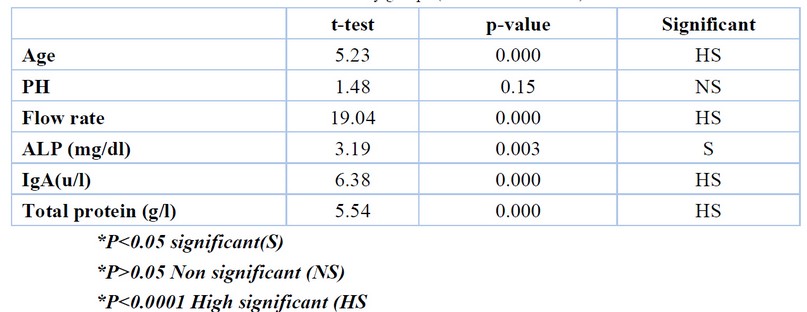
Table 3. t-test and significant levels of resting human saliva, flow rate, PH, and biochemical Data between the control & study groups (nonuser & OCS user)
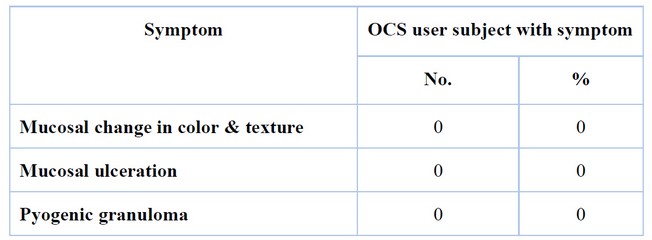
Table 4. Number & percentage (%) of subjects reporting oral symptoms with OCS users group
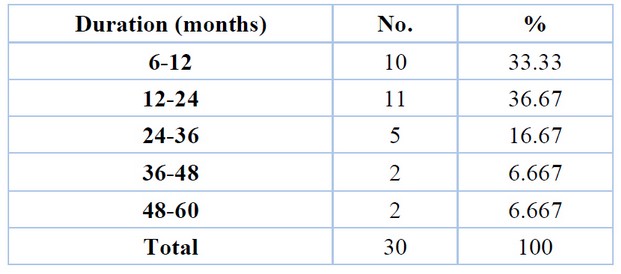
Table 5. Duration, number and percentage (%) of OCS Users women
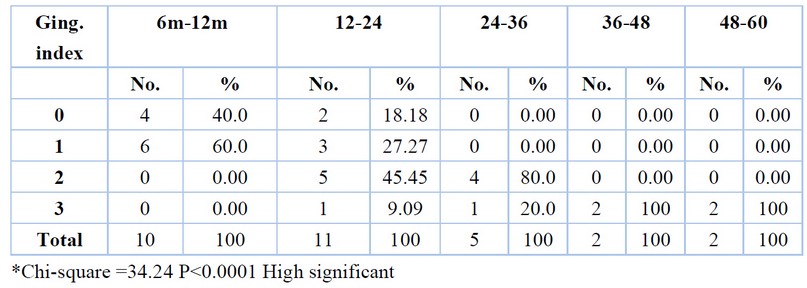
Table 6. Relation between duration for taking OCS and gingival index
DISCUSSION
This study was undertaken to evaluate the effects of oral contraceptive pills on salivary secretion composition and to examine any associated oral manifestations. Saliva can be collected in more significant amounts with less patient discomfort and more easy methods. However, the utility of saliva as a diagnostic fluid may be compromised due to its derivation from various sources (salivary glands, sloughed oral epithelial cells and gingival crevice fluid) in addition to its complex origin. The lyophilization process is useful to concentrate the salivary composition for a better salivary analysis because the concentration of enzymes & proteins in the saliva is more lowered than its concentration in serum. In this study, the flow rate of whole resting saliva between the two groups was found to be highly significantly different; the flow rate was increased in OCS users women, while in OCS nonusers women, the flow rate was lowered. This result is in agreement with results reported 6,7. Some studies have demonstrated the rate of flow was increased in patients taking contraceptives with no significant difference in flow rate in controls and females taking contraceptive pills, or there is constant mouth dryness observed in some women taking these pills 8. The exciting finding of salivary PH analysis in this study is that no significant change was observed in the saliva of OCS user & nonuser groups. The absence of PH changes in the saliva of OCS users group or women may be due to the increased salivary flow rate, which increased the bicarbonate (HCO3-) anion and other electrolytes levels in saliva compared to low salivary flow rate 9. This result agrees with that observed by 6, who found less variation in the PH of saliva in the OCS users group and who showed clearly the OCS drug (which is used as a medication for pregnancy prevention) is an anticipated factor that not only increases the salivary flow rate, might also have alterations in their biochemical constituents compared with OCS nonusers women's. The OCS users were affected by the drug & the estrogen hormone changes salivary composition and secretion levels. In the present study, a significant increase in the ALP content was observed in the saliva of OCS users women, especially in women associated with gingivitis; such a result is in agreement with that observed 4 that found a statistically significant increase of ALP activity in saliva from subjects with gingivitis & periodontal disease, so there is the correlation between the activity of examined salivary enzyme & value of the gingival index. The probable explanation for the increase in the ALP concentration in the saliva of OCS users may lead to gingival inflammation, redness & swelling; the cause of this condition could be due to estrogen level changes & duration of OCS intake, as with long time intake (more than one year) make the level of estrogen high. The data in this study showed a highly significant change in total protein content in the saliva of OCS users as the total protein concentration decreased after taking the pills & this result is in agreement with that found by 10. The synthesis of salivary protein varies with the hormones pattern & the decrease in total protein may be due to decrease glycoprotein levels. Despite that, some studies reported there were temporal variations in salivary proteins11,12.
There was a highly significant difference concerning IgA between OCS users & nonuser women. The IgA becomes at a lower concentration in the saliva of OCS users than in nonuser women. This result agrees with that found by 6, another result by 13, who reported that IgA levels in mixed unstimulated saliva were lowered in subjects with more gingival inflammation. The decrease in the IgA concentration in saliva may be related to an accumulation of bacteria on gingival tissues, especially when the salivary antibodies (like IgA) appear to be synthesized locally and react with strains of bacteria indigenous to the mouth, causing agglutination or aggregation & reduction of the proclivity of these organisms to join pellicle proteins on the tooth surface 14. However, this result disagrees with that founded by 15,2, who reported an increased SIgA level of whole saliva from patients with gingivitis. In table (6), the OCS user group had gingival inflammation; there was a highly significant difference between these two groups and a positive association between the gingival index and the duration of OCS intake. This result agrees with 16, 8, who found that the common oral finding of elevated levels of the ovarian hormones estrogen & progesterone that occur in OCS usage is increased gingival inflammation.
CONCLUSIONS
This study confirmed that systemic medications are the most critical factors affecting salivary flow rates and other parameters. In addition, after prolonged use of birth control pills, the important clinical symptom appears to be gingival inflammation, ranging from increased gingival exudates to the appearance of congestion and swelling in the gingival tissues. Female participants who present with gingival tissues and mucosal hyperplasia and who are not at the pubertal stage should be questioned about their drug intake in general and especially about OCPs. The treatment planning should be conservative & symptomatic. In contrast, in case of failure to achieve and return the lesion to a regular oral health status, the oral contraceptive pills should be discontinued or changed in consultation with the gynecologist for another mode of contraceptive method17,18,19.
Funding: "This research received no external funding."
Institutional Review Board StatementThe study was conducted according to the guidelines of the Declaration of Helsinki.
Informed Consent Statement: "Informed consent was obtained from all subjects involved in the study.
Data Availability Statement: This section provides details regarding where data supporting reported results can be found, including links to publicly archived datasets analyzed or generated during the study. Please refer to the suggested Data Availability Statements in the "Bionatura Research Data Policies" section at https://www.revistabionatura.com/policies.html. You might exclude this statement if the study did not report any data.
Acknowledgments: Authors acknowledge the Teaching staff in the College of Dentistry at the university of Baghdad and the university of Farahidy, especially the department of oral diagnosis.
REFERENCES
1. Ibarel-Rebot, N., Rieth, N., Lasne, F., Jaffre, C., & Collomp, K.. Oral contraceptive use and saliva diurnal pattern of metabolic steroid hormones in young healthy women. Contraception, 2015, 91(3), 245-247
2. Abd-Ali EH, Shaker NT. The effect of oral contraceptive on the oral health with the evaluation of Salivary IgA and Streptococcus mutans in some Iraqi women. Marietta Daily Journal 2013;10:52-63.
3. Michishiqe F, Kanno K, Yoshinaga S, Hinode D. Yozo Takehisa and Susuma Yasuoka: The Journal of medical investigation. 2006;53.
4. Todorovic T, Dozic I, Vicente-Barrero M, Ljuskovic B, Pejovic J, Marjanovic M Knezevic M, Med Oral Patol Oral Cir Bucal. 2006;2:5-9.
5. Brandtzaeg P. Do salivary antibodies reliably reflect both mucosal and systemic immunity. Ann NY Acad Sci. 2007;1098(3):288-311.
6. Karnik, Amruta A., et al. "Determination of salivary flow rate, pH, and dental caries during pregnancy: A study." Journal of Indian Academy of Oral Medicine and Radiology 27.3 (2015): 372
7. Al-Saffar M T. The Effects of Contraceptive Pills on Oral Health: A Review Study. 2019;12(3).
8. Najim, Y. S., Mohammed, Th. T. & Al-Khalani, F. M. H. The effect of the use of different levels of Azolla to male broilers diets in the production and physiological performance and economic feasibility. Biochemical and Cellular Archives. 2020, 20(1): 573-580. Doi: 10.35124/bca.2020.20.1.573.
9. Ghezzi EM. Lange LA. ship JA. Determination of variation of stimulated salivary flow rates. J Dent RES . 2000; 79(11):1874-8.
10. Magnusson I, Ericson T, Hugoson A. Dept. for Cariology and Laboratory for clinical chemistry, Faculty of Odontology, University of Goteborg, Goteborg, Sweden, 2004.
11. Pedersen, A. M. L., Sørensen, C. E., Proctor, G. B., Carpenter, G. H., & Ekström, J. Salivary secretion in health and disease. Journal of oral rehabilitation, 2018 45(9), 730-746
12. Hobi, A. A. .; AL-Helal, A. . Effect Of Alcoholic Extract Of Opuntia Ficus Indica On Semen Quality Of Awassi Rams After Different Cooling Periods. ). Journal of Life Science and Applied Research. 2021, 2, 9-13.
13. sola, G., Polizzi, A., Patini, R., Ferlito, S., Alibrandi, A., & Palazzo, G. Association among serum and salivary A. actinomycetemcomitans specific immunoglobulin antibodies and periodontitis. BMC Oral Health 2020, 20(1), 1-13.
14. Ferizi, L., Dragidella, F., Spahiu, L., Begzati, A., & Kotori, V. (2018). The influence of type 1 diabetes mellitus on dental caries and salivary composition. International journal of dentistry, 2018.
15. Gadekar, N. B., Hosmani, J. V., Bhat, K. G., Kotrashetti, V. S., Nayak, R. S., Babji, D. V., ... & Bansode, R. A. Detection of antibodies against Aggregatibacter actinomycetemcomitans in serum and saliva through ELISA in periodontally healthy individuals and individuals with chronic periodontitis. Microbial pathogenesis 2018, 125, 438-442.
16. Rukmini, J. N., Sachan, R., Sibi, N., Meghana, A., & Malar, C. I. Effect of menopause on saliva and dental health. Journal of International Society of Preventive & Community Dentistry, 2018. 8(6), 529.
17. Alkubaisy,S.A., A.A. Majid, S.M. Abdulateef, F.A. Al-Bazy, O.K. Attallah, O.M. Abdualmajeed, Th. T. Mohammed, F.M. Abdulateef, K.I. Mahmud. Effects of In-Ovo injection of Biotin on chick's embryonic development and physiological traits. IOP Conference Series: Earth and Environmental Science.2021, 761(1), 012111.
18. Khudair, M.Y Alyassein, R.N, Jasim, F.M. Improving the Quality of Ground Water in Some Areas of Al-Anbar Governorate by Recharging with Rainwater. IOP Conference Series: Earth and Environmental Science.2021, 761(1), 012009.
19. Ohmayed, K. H. .; Sharqi, . M. M. .; Rashid, H. M. . Comparison Of The Physical And Chemical Changes In Local Organic Waste After Cultivation Of The Ganoderma Lucidum Mushroom And Composting By Common Methods. Journal of Life Science and Applied Research. 2020, 1, 1-9.
Received: January 15, 2023 / Accepted: February 25, 2023 / Published:15 March 2023
Citation: Rasheed R H, Ahmed R F. The effects of oral birth control pills ( contraceptive pills ) intake on lyophilized saliva and its oral manifestations. Revis Bionatura 2023;8 (1) 71. http://dx.doi.org/10.21931/RB/2023.08.01.71
